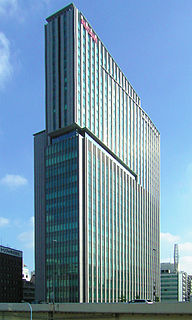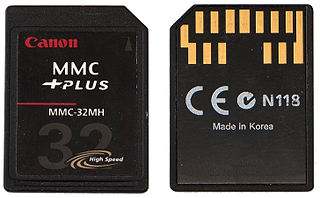Exchangeable image file format is a standard that specifies the formats for images, sound, and ancillary tags used by digital cameras, scanners and other systems handling image and sound files recorded by digital cameras. The specification uses the following existing file formats with the addition of specific metadata tags: JPEG discrete cosine transform (DCT) for compressed image files, TIFF Rev. 6.0 for uncompressed image files, and RIFF WAV for audio files. It is not used in JPEG 2000 or GIF.
The Caplio RX is a digital camera marketed to the public under the Ricoh brand. According to a Ricoh news release, the Caplio RX features the fastest shutter response time of any comparable camera in the world as of 4 March 2004, at 0.12 seconds.
The Caplio 400G Wide is a digital camera marketed to the public under the Ricoh brand. The camera's sensor resolution is 3.2 megapixels. It features a reinforced glass dust protector on the lens and rubber bolstering on some parts and buttons.
Digital Negative (DNG) is a patented, open lossless raw image format written by Adobe used for digital photography. Adobe's license allows use without cost on the condition that the licensee prominently displays text saying it is licensed from Adobe in source and documentation, and that the license may be revoked if the licensee brings any patent action against Adobe or its affiliates related to the reading or writing of files that comply with the DNG Specification. It was launched on September 27, 2004. The launch was accompanied by the first version of the DNG specification, plus various products, including a free-of-charge DNG converter utility. All Adobe photo manipulation software released since the launch supports DNG.
Ricoh Caplio R3 is a digital camera marketed to the public under the Ricoh brand.
This article discusses the cameras – mainly 35 mm SLRs – manufactured by Pentax Ricoh Imaging Corp. and its predecessors, Pentax Corporation and Asahi Optical Co., Ltd..
The Ricoh 500SE digital compact camera is suitable for outdoor photography and networkability. Capability includes external information such as GPS position or barcode numbers within the image headers. External vendors sell hardware and software for workflows involving GPS positioning or barcode scanning. Most NMEA compliant bluetooth GPS receivers can be used with this camera through its built in bluetooth communication capability. The body is resistant to dust and water, making it robust for many environments.
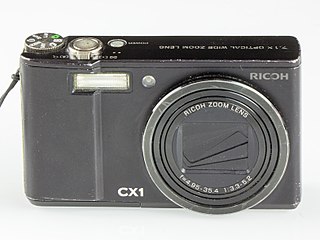
The Ricoh CX1 has been introduced by Ricoh in 2009. This is the first Ricoh camera to use a CMOS sensor. It allows it to operate at four frames/sec and perform hi-speed continuous shooting.
The Ricoh GR was a series of point-and-shoot, or compact, 35 mm film cameras made by Ricoh. The chronological list of these cameras are the GR1, GR10, GR1s, GR1v and GR21. The GR name was also used for Ricoh's GR series of digital cameras.
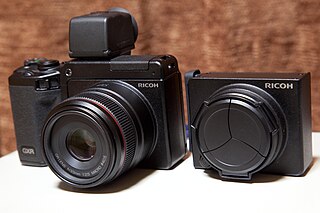
The Ricoh GXR is a compact digital camera first announced by Ricoh Company, Ltd, Tokyo on November 10, 2009. Unlike conventional cameras which either have a fixed lens and sensor or interchangeable lens and a fixed sensor, the GXR takes interchangeable units, each housing a lens, sensor and image processing engine. This allows each unit to have these features optimised to one another and a specific task, whereas with conventional interchangeable lens cameras, each different lens must use the same sensor and engine. The sealed units also prevent dust from reaching the sensor, which can be a problem with other cameras where the sensor is exposed whilst a lens is being changed. A significant disadvantage of this system is the extra cost involved in having to buy a whole new sensor with every new lens.

A mirrorless interchangeable lens camera (MILC), frequently simply mirrorless camera, and sometimes also called EVIL features a single, removable lens and uses a digital display system rather than an optical viewfinder. The word "mirrorless" indicates that the camera does not have an optical mirror or an optical viewfinder like a conventional single-lens reflex camera (SLR), but an electronic viewfinder which displays what the camera image sensor sees.
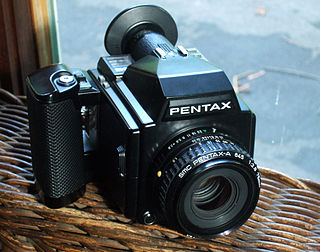
The Pentax 645 is a medium format single-lens reflex system camera manufactured by Pentax. It was introduced in 1984, along with a complementary line of lenses. It captures images nominally 6 cm × 4.5 cm on 120, 220, and 70 mm film, though the actual size of the images is 56 mm × 41.5 mm.

The Pentax K-3 is a 24-megapixel Pentax high-end digital single-lens reflex camera with an APS-C sensor, announced on 7 October 2013. The Pentax K-3 is the successor to both the K-5 II and K-5 IIs models, which have a 16-megapixel sensor. The K-5 II had an optical low pass filter or anti-aliasing (AA) filter that can prevent the appearance of moire patterning on the captured image. This filter reduces the sharpness of the image, so Pentax also produced the K-5 IIs which omitted this filter. In the K-3, Pentax obviated the need for providing two separate models by including a selectable AA filter "simulator". This mechanism vibrates the sensor when switched on, slightly blurring the image in a way that replaces the function of the optical AA filter, providing the same benefit as the filter in the K-5 II and other cameras with an optical AA filter. When the AA simulator is disabled, the sensor records a sharper image, as in the K-5 IIs.

The Ricoh GR is a digital large sensor compact camera announced by Ricoh on April 17, 2013, one of a number of Ricoh GR digital cameras. It was succeeded by the Ricoh GR II in 2015 and the Ricoh GR III in 2018.

The Pentax K-3 II is a flagship APS-C DSLR camera announced by Ricoh on April 22, 2015.

The Pentax K-1 is the first production Pentax full-frame digital SLR camera. As the flagship model of the Pentax K-mount system, it includes several new and improved features, including a five-axis SR II in-body image stabilization system, newly designed flexible tilt articulating screen mounted on four metal struts allowing for rotation about the optical axis in addition to upward and downward tilt, and improved autofocus and metering systems.
Ricoh is a Japanese multinational imaging and electronics company.

